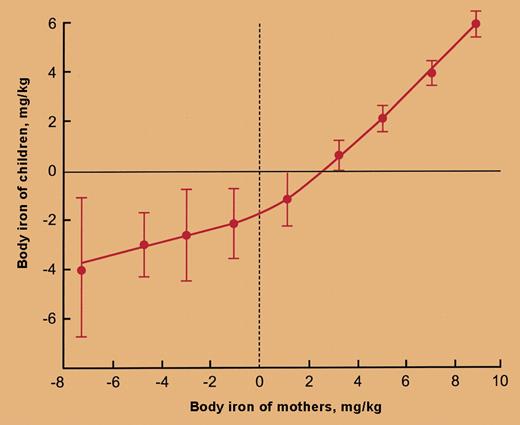Comment on Cook et al, page 1441
Quantitative measurement of body iron reveals a striking correlation of iron status between mothers and their children (r = 0.61, P < .001), providing strong evidence of the importance of dietary iron as a determinant of iron deficiency in populations at risk.
Iron deficiency is the joint outcome of increased physiologic requirements, limited supply, and/or increased blood loss. The paper by Cook and colleagues in this issue of Blood describes the effect of living at high altitude on body iron in 800 Bolivian mothers and their children. The study employs a method based on the measurement of serum transferrin receptor and serum ferritin and a formula by which the ratio of the 2 measurements is translated into body iron stores in mg/kg body weight. The original method has been validated in a group of volunteers subjected to quantitative phlebotomy.1 It provides a continuum of values ranging from normal, to storage iron depletion, and finally to tissue iron deficiency (anemia). In a previous study,2 the authors applied this method to a large number of serum samples collected as part of the National Health and Nutritional Examination Survey III (NHANES III) and in a study of iron fortification in anemic Vietnamese women. The unique advantages of the method are the use of only 2 parameters (ferritin and transferrin receptor) independent of transferrin saturation and hemoglobin measurements, and the use of minute volumes of serum suitable for collection by capillary specimens.FIG1
Body iron in children plotted at intervals of 2 mg/kg body iron in their mothers. See the complete figure in the article beginning on page 1441.
Body iron in children plotted at intervals of 2 mg/kg body iron in their mothers. See the complete figure in the article beginning on page 1441.
The present study shows no consistent effect of altitude on body iron in children. By contrast, body iron in women was significantly lower in subjects living at altitudes above 3000 meters. There was a linear increase in body iron with increasing age in children aged 0 to 4 years, with body iron reaching the same levels as in women by the age of 4. However, the most interesting finding in the present study was the close correlation between mother and child throughout the entire range of body iron values. The authors interpret this correlation as an indication of the importance of dietary iron, a factor common to members of the same household, in determining the iron status of a population.
The unique strength of this study is the meticulous care taken with developing the methodology, its standardization, and the ability to carry out accurate and reproducible measurements in 20-μL volume serum samples. The same amount of care was taken with statistical analysis, resulting in the spectacularly regular correlations found in the children regarding the effect of age and correlation with maternal iron status (see figure). The conclusions of this study point to interesting future challenges aimed at the elimination of iron deficiency in a population, by focusing on entire household units at risk instead of women or children alone.
A limitation of the present study was validation of negative values in subjects with depleted iron stores. This was quite easy in the original study of phlebotomized subjects1 because their initial (normal) hemoglobin was known. Definition of anemia in the present survey was more complicated as it is based on assumptions: that the normal value for each subject of comparable age (women, children) is known and is identical for all subjects, and that the corrections in hemoglobin made for altitude are valid. Nevertheless, these doubts would be relevant only for the negative values, whereas the important findings of the study, namely, the correlation between mothers and their children and the correlation with age in children, are all in the range of positive values based on serum ferritin and transferrin receptors, without resorting to hemoglobin measurements.
The authors have demonstrated the utility of a new and powerful tool for quantitating body iron, suitable for cross-sectional population surveys as well as for longitudinal interventional studies. Such a method would be ideally suited for future studies to evaluate the role of Helicobacter pylori gastritis and autoimmune gastritis in iron deficiency anemia refractory to oral iron treatment,3 and designing optimal strategies to improve iron status. ▪


This feature is available to Subscribers Only
Sign In or Create an Account Close Modal